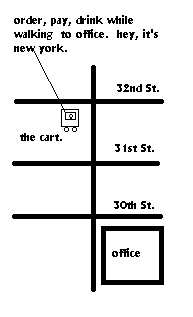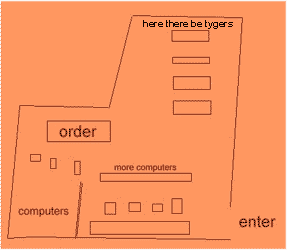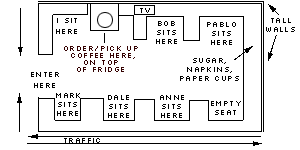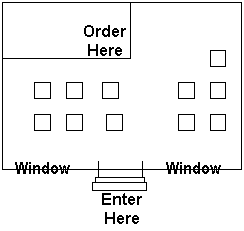| past petermemes | ||||||
|
March 29, 2000 March 26, 2000 Language is a virus. I've transcribed the brilliant essay, "The Metamorphoses of Epidemia", for your edification. It's a thought-provoking discussion of the spread of information in society, using an epidemiological model in discussing both transmission and vaccination. Particularly relevant to folks interested in The Tipping Point. J-PUNK! On Friday night, I danced my way to a higher ground at a Japanese Punk/Pop show. It was definitely the best live music I'd seen in months. The two amazing bands were Spoozys, a Man-or-Astroman?-like space surf freak fest (with a performance that was, frankly, far better than the last M-o-A? show I saw), and Lolita No. 18, a Ramones-descended all-girl band. Make sure to read their Profile. Listen to them cover the Ramone's "Rockaway Beach." (scroll down) Unfortunately, they've just ended their US tour. March 24, 2000 Hrm. Wow. It's been a while. The Tipping Point. This past week I finished The Tipping Point, Malcolm Gladwell's just published book on how certain cultural phenomena can be explained with an epidemiological model. It's a great (and fairly quick) read, filled with interesting stories and facts. My only issue with it is that Gladwell acts like the carpenter, for whom every problem is a nail--he sometimes applies the epidemiological model in ways that don't make sense. It's a forgivable lapse, seeing as how this book succeeds in an area where most don't even try--it gets the reader to think. Time willing, I hope to write a fuller review on Epinions. Follow this. It
brings me to thinking about how the internet allows us to explicitly
track the discrete aspects of social phenomena in a way too difficult
to do in 'the real world.' For example, about 7 months ago a friend
of mine ICQ'd me, pointing me to a site that linked to me with a
comment. Going there, I realized it was an old friend's site, and
clicking around it, I found a story of her travels, wherein she
pointed to the site of a woman she met. I followed that link, and,
intrigued by that woman's site, emailed her. She wrote back, and
in short order we met and started dating. (The dating didn't last,
which is why I'm not being explicit as to who these people are).
The point is, 1) Had my friend not ICQ'd me, I would likely never
have dated that woman and, 2) it's weird that I can so easily track
the whole process. March 17, 2000 Don't forget. I want your coffeehouse sketches and patterns! Pictures! Heather's corridor snap well-captures the feel of SXSW. And, uh, feel free to ignore those videos . Everything old is new again. This is a theme that cropped up a couple of times during presentations at SXSW. Before rampant mass media, the bulk of communication happened by word of mouth--person to person. The mass media, by providing a centralized source of Information, often overwhelmed the effects of word of mouth. In the interface culture panel I moderated, Steven Johnson discussed how the Web's technologies were leading to a return to polycentrism, the notion that there are myriad clusters with their own centers, typically affinity groups that share some interest or other commonality. A model I found useful is that of epidemiology. I've discussed it before, (scroll down a bit). To sum--memes spread through word of mouth communication in a viral fashion. The mass media irradiate this virus, overwhelming it with a present-everywhere-at-once (both figuratively and literally--broadcast waves *are* ever-present radiation), inoculating its effects. The internet's fluidity, however, allows memes to spread faster than the mass media can irradiate. Politics came up in the interface culture discussion, and I wrote this note to myself: "Was Jesse Ventura's election the result of our interface culture?" What effect will collaborative filtering (a key element to polycentrism) have on politics? What happens when I'm told, "People who voted for Candidate W also voted for Candidates X, Y, and Z"? What happens when people are treated as objects? As we further mediate social interaction by way of computer interfaces, it necessitates an alarming degree of discreteness. In the physical world, trust is a complex and fluid construct, the subtle utility of which is key to functioning in society. At Epinions, we allow you to trust or distrust someone at the click of the button. The metaphysical implications cause my head to spin.
Anyway, getting back to that old/new thing I started this ramble with, I also attended a session on "ebooks", which triggered memories of Scott McCloud's talk at Web99 on how comics were returning to their pre-Gutenberg roots. Scott pointed out that in ancient times, comics-like stories were told in long single threads, where the panels adjacent to the panel you were reading directly related. With the printing press and codices, comics acquired the left-to-right-then-hop-back-to-the-left again reading mode that we now use. Though seemingly minor, the cognitive shift is quite powerful--when you reach the right end of the page, the panels adjacent to the one you're reading aren't directly related. You lose your sense of flow. This is exacerbated by the end-of-page phenomenon, where you can't see what is to come. In his talk, Scott commented on how the form of pages have constrained the content of comics, and how the Web (and computers in general) will allow comics to return to the long-thread format, as he demonstrates in My Obsession with Chess. During the ebooks talk (see, it all comes together!), audience participants commented on the potential for ebooks to return us to the world of illuminated manuscripts, the pre-Gutenberg form of the book, and their colorful texts, annotated over time. Plus ca change, plus c'est la meme chose. March 16, 2000 March 15, 2000 SXSW Interactive is over. Fun. Busy. 10am --> 2am three days in a row. Reconnected with old friends, made some new ones. March 10, 2000 March 9, 2000 SXSW. I'll be there. Arrive Saturday night. Staying with these people. Blathering about "design" and "interface" and "culture" as if I actually know more than other people. Remember: the podium only gives the appearance of being expert. More of that sweet, sweet Java goodness. My dad offers up this drawing and explication of his favorite (now gone) coffee experience.
Dad raises a point I had not addressed previously. Atlas has no sidewalk seating, whereas Farley's does. Simply, sidewalk seating extends the coffeehouse directly into the community, an integration that blurs the lines between the two. And Judith offers up: March 8, 2000
And Luke Seemann offers up a diagram of his coffee klatsch, The Biz Pod:
March 7, 2000 What is information architecture? A number of people attempt to answer that question. In fact, a whole conference is devoted to defining it. I'm loathing that phrase, and what I see as its too-wide application. Architects make spaces, environments in which people engage. Increasingly, I (and others who do what I do) make tools to help people accomplish tasks. There's little architecture here--it's more industrial design. March 5, 2000 Blathering. Following in the footsteps of Wired's coverage, ZD News Network reports on the 5k award, with a coupla quotes from me. Coffeehouse patterns. As a coffeehouse obsessor, I wondered why I so disliked my closest coffeehouse (Atlas Cafe), and so loved Farley's and other establishments around the city. I've begin to pick apart design patterns in the layout of coffeehouse space. Here are a couple quick sketches of those spaces.
|
||||||





